When “entry level” cars come standard with what were once luxury car features such as climate control AC, good stereos and power everything (just about) they are no longer “entry level” cars.
They just don’t cost as much as luxury-badged cars.
The 2024 Mazda CX-90 isn’t entry-level – but it comes standard with something that’s getting hard to find in luxury-badged vehicles, especially those that cost less than $50,000 to start.
That thing being a standard six cylinder engine.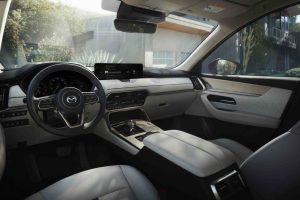
For just under $40k to start.
What It Is
The CX-90 is a full-size/three row crossover that seats 6-8 passengers, depending on the configuration. It is Mazda’s newest, largest model and its first-ever model to be powered by an all-new 3.3 liter inline six cylinder engine that is also its standard engine.
It’s available in either of two mild-hybrid configurations cycle the six off whenever possible, to increase fuel economy as much as possible.
There’s also a plug-in hybrid variant that splits the difference between the power of a six – and the economy of a four.
The CX-90 is also the only other Mazda – besides the Miata – that is built on a rear-drive layout. All-wheel-drive is standard, but unlike most non-luxury-badged AWD-equipped crossovers, the CX-90’s system isn’t default FWD – with most of the power going to the front wheels most of the time.
Like luxury-badged vehicles that typically cost thousands more, the CX-90’s set-up is rear-wheel-biased, with more of the engine’s power flowing to the rear wheels under normal driving conditions.
You used to have to pay luxury-brand money to get this.
Prices start at $39,595 for the 3.3 Turbo Select trim, which comes standard with a 280 horsepower version of the 3.3 liter in-line six, a mild-hybrid drivetrain, an eight speed automatic and all-wheel-drive.
If you want a stronger (340 horsepower) version of the six, it’s standard in the $51,750 Turbo S, which also has the mild-hybrid set-up.
If you’d like a more economical CX-90 with the power of the six, it’s standard in the plug-in hybrid (PHEV) version – which stickers for $47,445 to start. This one touts 323 horsepower – but it can also go about 26 miles without burning any gas at all. And you can still go close to 500 miles before you need to stop . . . for gas.
A top-of-the-line Turbo Premium Plus with the most powerful version of the six (plus the mild-hybrid set-up) standard quilted leather seats, second row captain’s chairs with console in between, digital main gauge cluster, 12.3 inch secondary touchscreen, heated and ventilated rear seats, a 12 speaker premium Bose audio system and 21 inch wheels/tires stickers for $59,950.
What’s New for 2024
The CX-90 is an all-new model that takes the place of the outgoing CX-9.
What’s Good
The four is optional.
The six is inline (and mounted front to rear rather than side-to-side).
A Miata for the driver who needs to be able to transport 6-8 passengers.
What’s Not So Good
Mazda recommends premium fuel for the strongest version of mild-hybrid CX-90, negating some of the money-savings of the mild-hybrid set-up.
Plug-in hybrid’s tow rating is just 3,500 lbs. (vs. up to 5,000 lbs. for CX-90s with the six).
AWD is standard.
The CX-90’s standard 3.3 liter six cylinder engine is almost a revolutionary act.
A counterrevolutionary act.
The trend has been going in the opposite direction for at least the past five years; as mentioned up above, it is now common for $50,000 cars to come standard with 2.0 liter fours. It used to be that when you paid that much money for a vehicle, you got at least a six.
The reason you often don’t – these days – has to do with current and looming federal fuel economy edicts that will shortly require each manufacturer’s fleet to average close to 50 MPG (hence Corporate Average Fuel Economy, or CAFE regs). The problem is that people who spend $50k and up on a vehicle may not want to spend that kind of money on a vehicle with a four under its hood.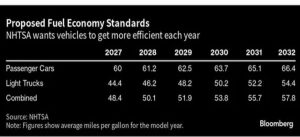
They might prefer a vehicle that costs just shy of $40k that comes standard with a six.
An in-line six.
The type you used to get in Jaguars, Benzes and BMWs when you spent Jaguar, Benz and BMW money.
How about one for Mazda money?
This one makes 280 horsepower in the standard configuration and it does not require premium fuel to make its touted power or deliver its advertised 24 city, 28 highway – which is significantly higher mileage (courtesy of the mild-hybrid set-up) than the VW Atlas manages with a standard 2.0 liter four that only makes 235 horsepower – and premium fuel is recommended. The VW’s optional 3.6 liter V6 only makes 276 horsepower – and only manages 18 city, 24 highway. Also, the least expensive version of the Atlas so equipped is $41,070 SE and it’s front wheel-drive.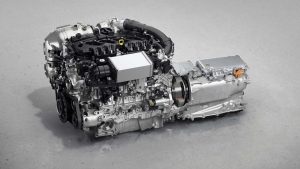
The CX-90 comes standard with AWD and (per the earlier mention) it’s a rear-biased set-up that is like the set-ups you’d find in luxury-priced vehicles from BMW, Jaguar, Mercedes and so on.
An eight speed automatic is the standard transmission.
Next up is a more potent version of the six – also paired with a mild-hybrid drivetrain. This combo offers 340 horsepower and 369 ft.-lbs, of torque. As a point of comparison, the BMW X5 comes standard with a similar drivetrain – 3.0 liter inline six with a mild-hybrid assist and 375 horsepower . . . for $65,200. The X5 is also a smaller (mid-sized) crossover that does not offer the third row that the full-sized Mazda comes standard with.
But the main thing you’re buying here – if you choose the 340 hp version of the Mazda’s in-line six – isn’t just more power.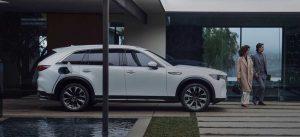
It’s more power without less mileage. This iteration returns almost exactly the same mileage – 23 city, 28 highway – as the 280 hp version of the six. The only downside here is that to get the power and the mileage you’ll need to feed this one premium gas.
But, you’ll also be able to pull a 5,000 lb. trailer; the standard CX-90 with the 280 hp version of this six is only rated to pull a maximum of 3,500 lbs. However, you can upgrade that to 5,000 lbs. by choosing the Preferred Plus package.
Finally, there’s the option of going with a four rather than the standard six.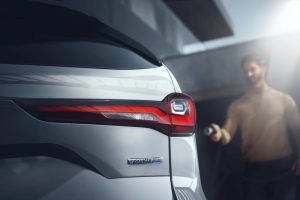
This is is the plug-in hybrid version of the CX-90. A 2.5 liter four is paired with a more present hybrid system that has the power to propel the vehicle all by itself (without the engine) for up to about 26 miles. And it can be plugged-in, which means the battery can be recharged and ready to take you another 26 miles without using the engine (and burning gas) to to charge it.
Mazda says you can fully recharge its 17.8 kWh battery pack in about two hours at home, using a 240V (level II) dryer-type outlet.
But – unlike an EV (sans the “P”) you don’t have to plug it in.
This version of the CX-90 also touts more power (323 horsepower) than the standard six and nearly as much as the more powerful, optional six – with the potential to use less gas than the standard (280 horsepower) version of the six.
On the downside, the plug-in hybrid also wants premium fuel to deliver on its power and mileage claims – and the max tow rating reverts to 3,500 lbs.
An inline six is a long engine – relative to a V6. That’s why you generally do not find inline sixes in non-luxury-badged vehicles, which are usually front-wheel-drive-based to reduce manufacturing costs by packaging the engine and transaxle together into a more compact and sideways-mounted assembly that’s easier and faster to install as the vehicle rolls down the assembly line.
The inline six is more suited to the front-to-back (rear-drive-based) layout; i.e., the more expensive layout. But the cost is worth it – in terms of a more balanced and better handling (and feeling) vehicle. The weight of the drivetrain – the engine, transmission and drive axle – is spread out more evenly over the length of the vehicle rather than crammed together up front and the power is distributed more evenly. 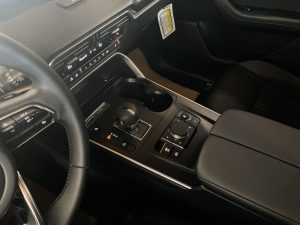
Especially if you don’t have to pay luxury-badge money for it.
That’s perhaps the most astounding thing about this Mazda. Before you even drive it. And when you do, you wonder why others are paying more for less.
The inline six has other virtues, too. This configuration is lighter – and smoother – than the V6 configuration because the in-line six is itself naturally balanced and for that reason does not need weighty counterbalancers to tamp down vibrations. And because its reciprocating assembly (crankshaft, rods and pistons) are light it revs more freely and smoothly. This is another reason why you used to find inline sixes in luxury-badged vehicles and V6s in less-expensive vehicles.
And the reason you can find it here – in an affordable vehicle – is because Mazda also offers the plug-in hybrid drivetrain. It gets credit (from the government) for burning less gas and “emitting” less gas (i.e., the carbon dioxide that results from burning gas). C02 does not cause air pollution but it is framed as being an agent of “climate change” and the regs that have been pushing sixes – and engines, generally – off the market are premised on that false assertion, not unlike the false hysteria about “asymptomatic spreaders” during the “pandemic.”
Most other manufacturers have taken the route of making their formerly available sixes optional – in order to sell fewer of them (this helps with the regs). Mazda has done the reverse. It offers the four (and the plug-in hybrid setup) so that it can sell more sixes.
Not that there’s anything wrong with the plug-in hybrid setup.
Mazda says it can return 56 MPG in combined (gas plus hybrid) driving and can go almost 500 miles (on a full tank and full charge) before you’ll need to stop for either gas or a charge. As opposed to an entirely electric vehicle, which would have to stop much sooner and – make you wait much longer. The hybrid setup also greatly reduces the EV problem of battery fatigue – which arises from heavy discharge/recharge cycles.
A hybrid’s battery is never heavily discharged. The carry-it-with-you generator (i.e., the engine) prevents that. And because the hybrid can keep going (using its engine) you never have to “fast” charge the battery, in order to get going without having to wait all day to get going.
The hybrid setup is also extremely smooth – and quiet – because (like an EV) there’s no engine. Or at least – in this case- one that’s not always running.
The system cycles it on when needed – and off when it’s not and these transitions are all-but-unnoticeable, especially since there’s no tach in the gauge cluster to register engine RPMs. Instead, there’s a power/charge meter and dual-fuel (electricity and gas) gauges. It’s very EV-like, excepting the having to worry about how much range you’ve got left – and how much time you’ve got.
The CX-90 isn’t that much bigger than the CX-9 it replaces. The latter was 199.4 inches long; the former is 200.8 inches long – a difference of about an inch-and-a-half in overall length.
But it’s noticeably roomier – and more versatile.
First, it can seat six. Or seven. Or up to eight – depending on the configuration. You can go with a second and third row bench – and eight passenger capacity – or second row captain’s chairs and a pair of third row seats, for six. Or a three-row bench in back – so as to seat seven.
The CX-9 could only seat up to seven – and its third row was not really adult-usable.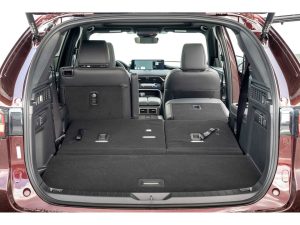
Cargo space behind the CX-90’s third row is still about the same (14.9 cubic feet vs. 14.3 previously) but total space – with the third and second rows down – goes up to 74.2 cubic feet vs. 71.2 previously.
There’s also close to two inches more first-row legroom (41.7 inches now) than in the outgoing CX-9 (40.1 inches).
But this Mazda isn’t just practical. It is luxurious.
Even the base trim comes standard with three-zone climate control, a leather-wrapped steering wheel and gear selector, simulated leather seat covers, an eight speaker stereo, and a 10.25 inch LCD touchscreen. Plus the standard six.
Just like the luxury-badged (and priced) stuff – but without the price. Or the standard four.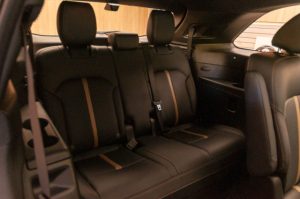
And because it’s so affordable – even with the standard six – you may be able to afford to opt for such available amenities as the 12 speaker Bose premium audio system, larger (12.3 inch) touchscreen, digital instrument cluster, heated second row seats, steering wheel and panorama moonroof.
That’s the real story here. Mazda has managed to offer everything – and more – that you used to have to spend luxury car money to get.
For less than luxury-car money.
The Rest
One thing you can’t get together in the CX-90 is the high-powered version of the six and eight-passenger capacity. Turbo S models all come standard (only) with the two-person third row seats. You can, however, get ventilated second row seats – and quilted leather upholstery for all the seats.
Mazda also includes a standard 12V power point in all trims – and it’s up front and accessible to the driver on the forward part of the center console.
Had Mazda decided to offer this CX-90 without standard AWD, the base price might have been lower than that of the outgoing CX-9 (and allowed for the kind of rear-drive action you can get in a Miata, only with two more cylinders and a lot more power).
The Bottom Line
Maybe next year Mazda will offer a V8. But in the meanwhile, a standard six is almost as wonderfully heretical.
. . .
If you like what you’ve found here please consider supporting EPautos.
We depend on you to keep the wheels turning!
Our donate button is here.
If you prefer not to use PayPal, our mailing address is:
EPautos
721 Hummingbird Lane SE
Copper Hill, VA 24079
PS: Get an EPautos magnet or sticker or coaster in return for a $20 or more one-time donation or a $10 or more monthly recurring donation. (Please be sure to tell us you want a magnet or sticker or coaster – and also, provide an address, so we know where to mail the thing!)
If you like items like the Keeeeeeev T shirt pictured below, you can find that and more at the EPautos store!



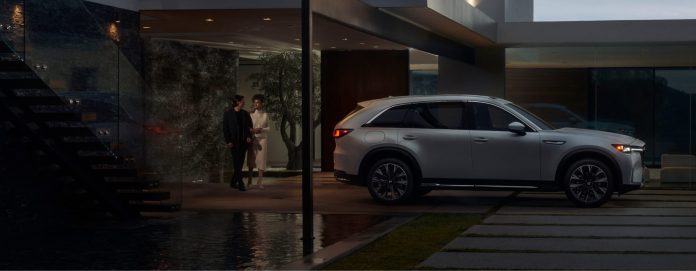

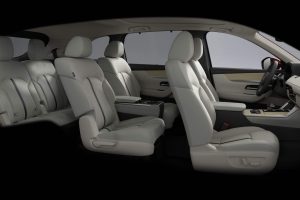


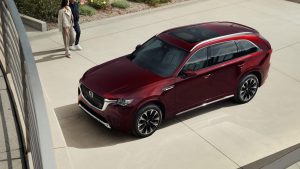







Daughter and I will go “kick tires” on this model soon. Couple glitches already noted in the owner/enthusiast blog I’m concerned with. Drivers side mirror vibrates at freeway speeds, no fix (yet) from Mazda. My Escape does this it’s really annoying. Driver door noise traced to the wire bundle between door and body rubbing, the fix is to wrap it with foam or felt. Rear hatch rattle blamed on lack of lube in the latch mechanism.
Drivetrain annoyance when slowing to an almost stop then taking off, shudders at this point switching from battery to engine, no fix yet but seems better with A.S.S. turned off. Road noise with the 21” wheel package.
So, I still want to check it out would rather rent for week long shake down first.
Eric glad to see you had an opportunity to review the CX-90. Would you be able to comment on the review by “The Car Care Nut”, Should You Buy a 2024 Mazda CX-90 Inline 6? A Mechanic’s Review, https://www.youtube.com/watch?v=Dral93gmVkM&t=1637s ? I’m concerned about some of the engineering choices Mazda made.
Thanks
Hi Gary,
I will take a look when I get a little free time and report back!
Hi Gary,
Ok, I had a chance to watch some of the video, in particular, the portion where the guy gets into the rear-mounted timing chain. This could be an issue – in terms of repair costs – if the timing chain needs to be replaced. Or – rather – when. Timing chains are (generally) lifetime parts; meaning, they may stretch a little over many years but they rarely fail or stretch so much that they need to be replaced before the engine needs to be rebuilt. My Nissan truck is 22 years old and has the original timing chain. The engine runs perfectly.
Timing belts, on the other hand, typically have to be replaced long before the engine wears out. As this is a brand-new engine, there’s really no way to know, in advance, whether it will have problems involving its timing chain. So the question becomes: Would I – as a potential buyer – take the risk?
If this were a Mercedes or BMW, my answer would be . . . No. At least, not if I planned to keep the car after the warranty ran out (and without buying an extended warranty). But this is a Mazda – and the company has a well-deserved reputation for designing solid (durable, reliable) engines.
I hope this one proves to be that – because I hope this Mazda succeeds. We need more like it!
Eric,
Thank you for taking the time. It was the placement of the timing belt that jumped out to me. I’ve used Amsoil products since the late 70’s and would do the same if I purchased the CX-90. Believing that would contribute to a long life. Thank you again for your time and honest reporting. I have not yet found another Automotive Journalist that sees what they are doing to our ability to be mobile and free.
Happy to, Gary – and thanks for the kind words!
I’m going to drive one of these at a the same price point as my BMW X3 and see what I think. I could get more car for the same money and might even like it more. Any thoughts?
Kudos to Mazda for offering a middle finger to our “beloved” tyrants in office. Now if only they could offer a diesel version (sans the emissions crap). Then again, such a pleasure would probably get them booted from the US market entirely.
Go Mazda !
So how does Mazda manage to get this set up to an more affordable price then the competition?
At least a few automakers are still trying to go around the no bigger than a 2.0!
Ahhhhhha…….An inline six…..Have not driven one since my 1978 Ford Granada.
Several other features in the plus column:
That drive config allows the wheels to be placed near the corners, which they did, better ride and handling than the usual FWD tuck and porpoise.
The rear view mirrors are door panel mounted, NOT corner of the glass/into the A pillar mounted – buys you a bit better visibility especially helpful in busy in town driving.
The dash info screen is down and into the dash, not plastered as an after thought up front or sticking halfway up the windshield sight line.
Holy moly! Good by 2018 Grand Cherokee hello Mazda! The one Ornimental brand our family embraces. Kids over the last 15 years two 3s, now a 2015 Mazda 6 all absolutely trouble free and a blast to drive.
Now, can any of the assist features be programmed off, and stay off?
Great review. God bless Mazda for carrying the torch in dark times. Sounds like a great design at a great value.
Thanks, Mark!
It’s little islands of sanity that keep me going…
looks nice. might compete for our typical grand cherokee. Unless the GC gets the Hurricane engine.
Love the long hood and front wheel placement (forward).